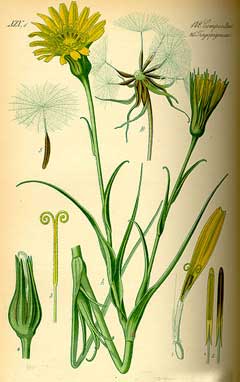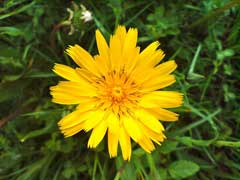 |
|
commons.wikimedia.org/wiki/File:Illustration_Tragopogon_pratensis0.jpg |
 |
|
Translate this page:
Summary
Physical Characteristics

 Tragopogon pratensis is a ANNUAL/PERENNIAL growing to 0.6 m (2ft).
Tragopogon pratensis is a ANNUAL/PERENNIAL growing to 0.6 m (2ft).
See above for USDA hardiness. It is hardy to UK zone 3 and is not frost tender. It is in flower from June to July, and the seeds ripen from August to September. The species is hermaphrodite (has both male and female organs) and is pollinated by Bees, flies. The plant is self-fertile.
Suitable for: light (sandy), medium (loamy) and heavy (clay) soils, prefers well-drained soil and can grow in heavy clay soil. Suitable pH: mildly acid, neutral and basic (mildly alkaline) soils. It cannot grow in the shade. It prefers moist soil. The plant can tolerates strong winds but not maritime exposure.
UK Hardiness Map
US Hardiness Map
Synonyms
Plant Habitats
Meadow; Cultivated Beds;
Edible Uses
Edible Parts: Leaves Root Shoots Stem
Edible Uses:
Root - raw or cooked[2, 9, 12, 52, 100]. The roots have a sweet flavour due to their inulin content[7]. The young roots can be eaten raw whilst older roots are best cooked like parsnips or salsify[9]. They are often blanched before use[183]. Young leaves and shoots - raw or cooked[2, 5, 12, 52, 62, 183]. They can be added to mixed salads or used in soups etc[7, 9]. The leaves are best used as they come into growth in the spring[9]. The flowering stem, including the buds, is cooked and served like asparagus[183].
References More on Edible Uses
Medicinal Uses
Plants For A Future can not take any responsibility for any adverse effects from the use of plants. Always seek advice from a professional before using a plant medicinally.
Astringent Depurative Diuretic Expectorant Stomachic
Goat's beard is considered to be a useful remedy for the liver and gallbladder[254]. It appears to have a detoxifying effect and may stimulate the appetite and digestion. Its high inulin content makes this herb a useful food for diabetics since inulin is a nutrient made of fructose rather than glucose units and therefore does not raise blood sugar levels[254]. The root is astringent, depurative, diuretic, expectorant, nutritive and stomachic[7, 21]. A syrup made from the root gives great relief in cases of obstinate coughs and bronchitis[7]. A decoction of the root is given in the treatment of heartburn, loss of appetite and disorders of the breast or liver[240]. The root is harvested in the autumn and dried for later use[7]. The fresh juice of young plants is said to be a good dissolver of bile, relieving the stomach without side effects[4].
References More on Medicinal Uses
The Bookshop: Edible Plant Books
Our Latest books on Perennial Plants For Food Forests and Permaculture Gardens in paperback or digital formats.

Edible Tropical Plants
Food Forest Plants for Hotter Conditions: 250+ Plants For Tropical Food Forests & Permaculture Gardens.
More

Edible Temperate Plants
Plants for Your Food Forest: 500 Plants for Temperate Food Forests & Permaculture Gardens.
More

More Books
PFAF have eight books available in paperback and digital formats. Browse the shop for more information.
Shop Now
Other Uses
Cosmetic
An infusion of the petals is used to clear the skin and lighten freckles[7]. A distilled water made from the plant is used in cleansing lotions for dry skins[7].
Special Uses
References More on Other Uses
Cultivation details
Succeeds in ordinary garden soils, including heavy clays[200]. Goat's beard was formerly cultivated as a vegetable, though it has now fallen into disuse[2, 4]. Grows well in the summer meadow[24]. The flowers open at daybreak and close before noon[4].
References Carbon Farming Information and Carbon Sequestration Information
Temperature Converter
Type a value in the Celsius field to convert the value to Fahrenheit:
Fahrenheit:
The PFAF Bookshop
Plants For A Future have a number of books available in paperback and digital form. Book titles include Edible Plants, Edible Perennials, Edible Trees,Edible Shrubs, Woodland Gardening, and Temperate Food Forest Plants. Our new book is Food Forest Plants For Hotter Conditions (Tropical and Sub-Tropical).
Shop Now
Plant Propagation
Seed - sow spring in situ. Make sure to water the seed in if the weather is dry.
Other Names
If available other names are mentioned here
Native Range
TEMPERATE ASIA: Turkey (n.w. & e.), Russian Federation-Western Siberia (Western Siberia), Russian Federation-Eastern Siberia (Eastern Siberia), Kazakhstan, Mongolia EUROPE: Denmark, Finland, United Kingdom, Ireland, Norway, Sweden, Austria, Belgium, Switzerland, Czech Republic, Germany, Hungary, Netherlands, Poland, Slovakia, Russian Federation (European part), Belarus, Estonia, Lithuania, Latvia, Moldova, Ukraine, Albania, Bulgaria, Bosnia and Herzegovina, Greece, Croatia, Italy, North Macedonia, Montenegro, Romania, Serbia, Slovenia, Spain, France
Weed Potential
Right plant wrong place. We are currently updating this section.
Please note that a plant may be invasive in one area but may not in your area so it's worth checking.
Conservation Status
IUCN Red List of Threatened Plants Status :

Growth: S = slow M = medium F = fast. Soil: L = light (sandy) M = medium H = heavy (clay). pH: A = acid N = neutral B = basic (alkaline). Shade: F = full shade S = semi-shade N = no shade. Moisture: D = dry M = Moist We = wet Wa = water.
Now available:
Food Forest Plants for Mediterranean Conditions
350+ Perennial Plants For Mediterranean and Drier Food Forests and Permaculture Gardens.
[Paperback and eBook]
This is the third in Plants For A Future's series of plant guides for food forests tailored to
specific climate zones. Following volumes on temperate and tropical ecosystems, this book focuses
on species suited to Mediterranean conditions—regions with hot, dry summers and cool, wet winters,
often facing the added challenge of climate change.
Read More
Expert comment
Author
L.
Botanical References
17200
Links / References
For a list of references used on this page please go here
Readers comment